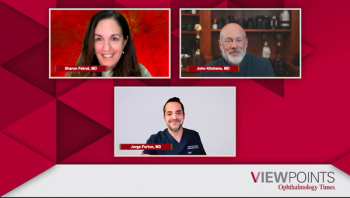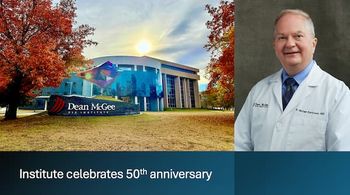
- Ophthalmology Times: September 15, 2020
- Volume 45
- Issue 15
Study: Patients at moderate risk of ectasia stable 2 years after treatment
Researchers evaluate effects of procedure on patients with abnormal topography
The visual outcomes of the SMILE Xtra (Carl Zeiss Meditec) study of small-incision lenticule extraction with accelerated corneal cross-linking were comparable from 1 week to 2 years postoperatively, as were the safety, stability, and predictability—important findings for patients at moderate risk of ectasia.
The study was undertaken to evaluate the long-term effects of the procedure in patients who had abnormal topography, low residual stromal bed thickness, higher refractive errors, and thin preoperative corneal thickness, according to Sung Min Kim, MD, from the NUNEMISO Eye Center in Seoul, South Korea. In addition, investigators wanted to determine the safety and clinical effect of the Xtra energy protocol in various patient subgroups.
Related:
The study included patients who underwent the SMILE Xtra treatment from March 2016 to February 2017 and had been followed for 2 years postoperatively.
The Xtra protocol included soaking with a 0.25% riboflavin solution for 90 seconds, followed by ultraviolet A light exposure at 30 mW/cm2 for 60 seconds. This approach provided 1.8 J/cm2 of total energy, Kim said.
The inclusion criterion for the SMILE Xtra candidates was moderate-risk patients determined based on the Randleman Ectasia Score System.
The patients were divided into 4 subgroups based on their characteristics: abnormal topography, low residual stromal bed thickness under 300 μm, high refractive errors exceeding -9.5 D or lenticule thickness exceeding 130 μm, or a thin preoperative central corneal thickness under 510 μm.
Patients were excluded if they were under 18 years old, had keratoconus or suspected they had keratoconus, had a central corneal thickness under 480 μm, had a residual stromal bed under 290 μm, had been lost to follow-up, or had undergone a reoperation.
Related:
Included were 130 eyes of 65 patients (mean age, 26.4 years). The mean preoperative sphere was -6.22 D, and the mean cylinder was -1.59 D.
“The efficacy index for the SMILE Xtra treatment was 1.13, which was comparable to that of the patients who underwent the SMILE procedure in the same clinic. Only 61% of patients achieved a visual acuity of 1.08 1 day after the procedure, but at 2 years that increased to 1.08 or better in 95% of patients,” Kim explained.
Kim noted that when the SMILE Xtra procedure was compared with the SMILE procedure, the vision on the first day postoperatively was significantly lower in the Xtra group; however, from the 1-week time point out to 2 years, the results of the 2 procedures were comparable.
The safety, stability, and predictability of the Xtra procedure were all good. The safety index was 1.16. Only 1 line of vision was lost at 2 years among all the study patients.
Two eyes were enhanced with PRK at 1 year; these eyes were excluded from the study.
Finally, at the final visit at 2 years, 97.7% were within ± 0.05 D of the targeted refraction.
Related: PODCAST:
The analysis of the 4 subgroups did not find any significant differences in the visual recovery and refractive change over the 2 year course of study.
The patients in the group characterized by a high refractive error tended toward slight regression and lower vision at the final evaluation compared with the other 3 groups. However, the differences were not significant.
The differences in the endothelial cell counts from preoperatively to postoperatively were not significant in the entire study cohort or among the subgroups.
“The Xtra corneal crosslinking did not result in significant endothelial cell loss over the long term,” Kim said.
Related:
The investigators concluded that with the exception of the early postoperative period, the SMILE Xtra treatment demonstrated comparable visual outcomes from 1 week to 2 years. The safety, stability, and predictability also were stable.
Finally, the characteristics of the subgroups did not affect the clinical outcomes after SMILE Xtra.
“SMILE, in combination with the 1.8 J/cm2 Xtra protocol, seems to be an effective, safe, and predictable treatment strategy in patients who are at moderate risk,” Kim concluded.
Articles in this issue
about 5 years ago
Platform for measuring contrast sensitivity shows potential for AMDabout 5 years ago
Persistent retinal detachment connected to retinoblastomaabout 5 years ago
AI algorithms: a work in progressabout 5 years ago
Targeting AMD patient treatment burdenabout 5 years ago
Options give 1-2 punch to metastatic uveal melanomaabout 5 years ago
Reducing burden on veterans undergoing cataract surgeryabout 5 years ago
Surgery during the COVID-19 pandemic: Staying sharpabout 5 years ago
Boosting short-term dry eye management in patientsabout 5 years ago
Saving memories: Do anti-VEGF agents contribute to cognitive loss?Newsletter
Don’t miss out—get Ophthalmology Times updates on the latest clinical advancements and expert interviews, straight to your inbox.











































.png)


